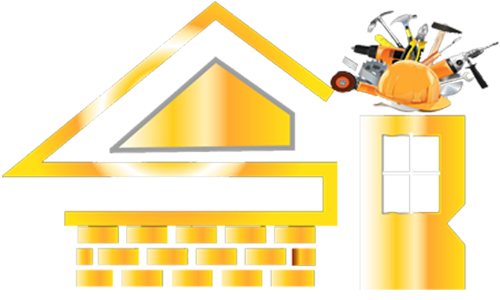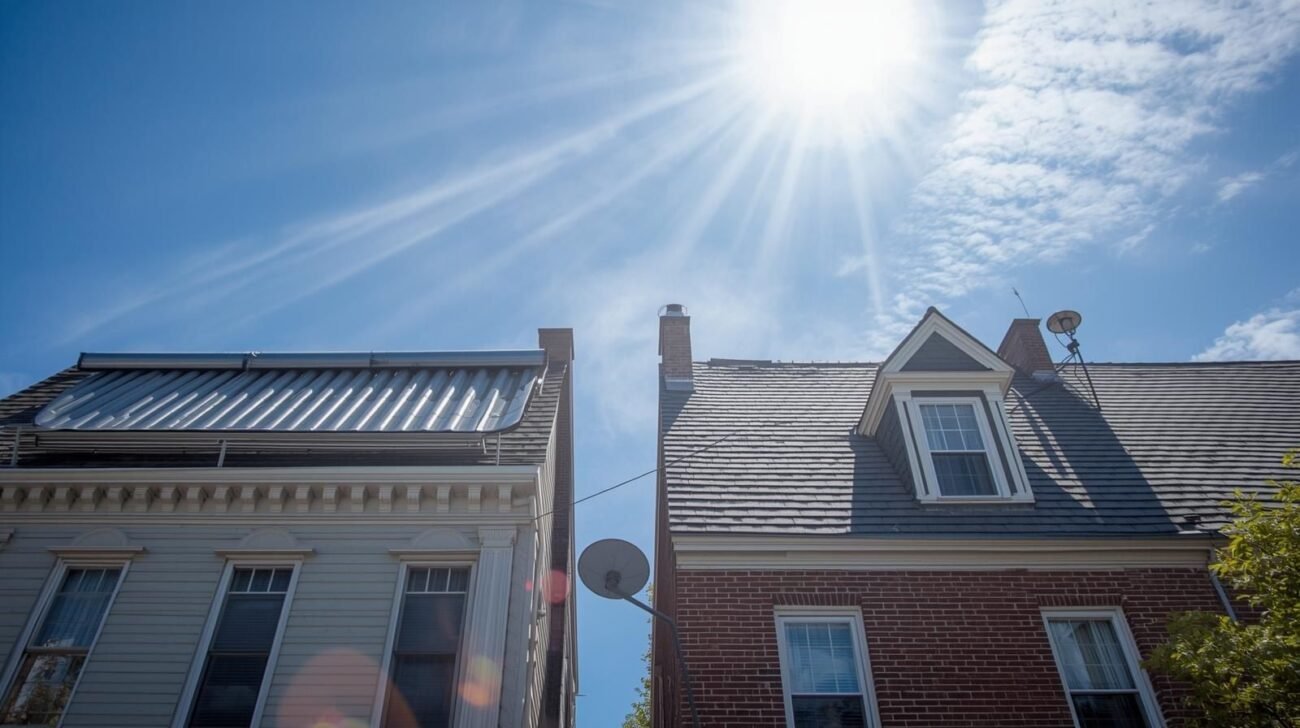
Have you ever wondered what a roof type is and why it matters? A roof type refers to the shape and materials used to protect your home. From flat to sloped roofs, each design has its benefits and limitations. Some are better at preventing snow and rain, while others might be more energy-efficient.
When you choose the best roof type, you’re setting your home up for long-term comfort and protection. In this detailed guide, we will explore the best roof type for Brooklyn’s residential homes.
Best Roof Type for Residential Homes in Brooklyn, NYC
Brooklyn’s weather and unique architectural landscape require a roof type that can protect from the elements and complement your home’s style. The best roof type for a residential home in Brooklyn means considering factors like durability, energy efficiency, and maintenance needs. Here are some of the top roof types you’ll find in Brooklyn’s residential homes, each with its advantages and disadvantages:

1. Flat Roof
- Info: Flat roofs are common in Brooklyn, especially in modern homes or urban-style buildings.
- Advantages:
- Affordable: One of the most budget-friendly roofing options available.
- Extra Space: Suitable for a rooftop garden, terrace, or additional living area.
- Easy to Maintain: Less complex design makes repairs straightforward.
- Energy Efficient: Flat roofs allow easy installation of solar panels. That helps to reduce energy cost.
- Modern Look: This style suits well with modern or industrial-style homes in urban settings.
- Disadvantages:
- Water Pooling: Without proper drainage, water can accumulate, causing leaks.
- Shorter Lifespan: More prone to damage and wear compared to sloped roofs.
- High Maintenance: Requires regular inspections to prevent damage from water buildup.
- Not Ideal for Snow: Snow can accumulate on flat roofs, which causes extra weight and potential leaks.

2. Gable Roof
- Info: A gable roof is one of the most common types, featuring two sloped sides that meet at a ridge.
Advantages:
- Classic Design: A timeless look that suits many architectural styles.
- Good Ventilation: The design allows for natural airflow. It reduces heat in the summer.
- Great for Snow and Rain: Water and snow easily slide off the steep slopes.
- Cost-Effective: Simple design, making it cheaper to install.
- Increases Attic Space: Provides additional storage space in the attic.
Disadvantages:
- Less wind Resistant: High winds can make gable roofs vulnerable, especially in stormy conditions.
- Limited Design: Not ideal for all architectural styles, particularly those with exceptionally modern or minimalist designs.
- Requires Regular Maintenance: The steep angles may require more frequent maintenance.
- Higher Installation Costs in Some Cases: In homes with larger or more complex designs, installation costs may be higher.
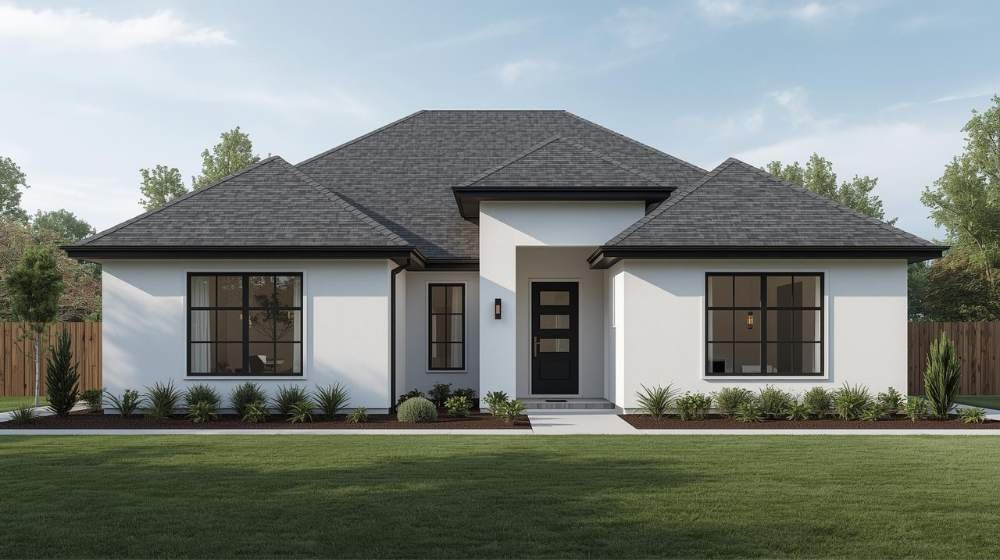
3. Hip Roof
- Info: A hip roof has four sloping sides, which makes it more stable and resistant to wind.
Advantages:
- Strong and Wind Resistant: Four sloping sides make it more stable during high winds.
- Better Protection Against Weather: Snow and rain are efficiently shed, which reduces the chance of leaks.
- Durable: Long-lasting roof type that requires less maintenance than simpler designs.
- Energy Efficient: Helps keep homes insulated in both summer and winter.
- Eye-catchy Look: Adds a symmetrical, balanced look to homes, enhancing curb appeal.
Disadvantages:
- Higher Cost: More expensive to install due to its complex design.
- Less roof Space: The sloped sides limit the amount of usable upper space.
- Complicated Installation: Requires skilled contractors and takes longer to build.
- Ice Dams: In colder climates, ice dams can form, potentially leading to water damage.
4. Mansard Roof
- Info: A mansard roof has two slopes on each side, with the lower slope being much steeper.
Advantages:
- Maximises Living Space: Steep lower slopes create additional attic space for extra rooms.
- Elegant Design: Ideal for historic and Victorian-style homes.
- Increased Property Value: Enhances the stylish value of the home.
- Extra Floor Space: Provides a second floor under the roof, great for additional rooms.
- Suitable for Customisation: Allows for a variety of architectural designs.
Disadvantages:
- Expensive to Build: Mansard roofs are complex and require a high level of expertise. This is costly to install.
- High Maintenance: The steep slopes can make it harder to maintain and inspect.
- Not Common in All Neighbourhoods: May not blend well with homes in more modern or minimalist neighbourhoods.
- Susceptible to Weathering: The lower, steeper slopes may experience wear and tear more rapidly than other roof types.
5. Gambrel Roof
- Info: Common in barns, the gambrel roof has two slopes on each side, with the lower slope being steeper.
Advantages:
- Extra Space: The steep slopes provide additional upper-floor or attic space, perfect for storage or rooms.
- Traditional Look: Popular in barns and colonial homes, it offers a charming, historic feel.
- Cost-Effective: Cheaper than some other steep roofs, like mansard roofs.
- Good Drainage: Snow and rain slide off easily due to the steep lower slope.
- Easy to Insulate: The design enables sound insulation, keeping homes warm in winter.
Disadvantages:
- Requires More Maintenance: The unique shape can make it harder to inspect and maintain.
- Less Wind-Resistant: Not as stable in high winds as hip roofs.
- More Complex Construction: The design can be more difficult to build
- Not Ideal for All Areas: May not complement more modern home styles well.
6. Saltbox Roof
- Info: A saltbox roof is asymmetrical, with one side having a long slope and the other a shorter slope.
- Advantages:
- Unique Design: The asymmetrical shape makes it stand out and adds character to your home.
- Good for Rain and Snow: The steep slope helps rain and snow slide off easily.
- Works Well for Historic Homes: Common in older homes, especially in traditional neighbourhoods.
- Extra Attic Space: Provides additional storage space or room.
- Appealing Look: Gives homes a distinctive and charming style.
- Disadvantages:
- Expensive: The complex design can make construction costs higher.
- Limited Style Options: May not fit modern or minimalist designs.
- Requires More Maintenance: Needs regular checks, especially at the joint where the slopes meet.
- Not Ideal for Urban Areas: The design may not blend well with city buildings.
7. A-Frame Roof
- Info: An A-frame roof is shaped like the letter “A,” with steep sides that meet at a peak.
Advantages:
- Good for Snow: The steep pitch is great for shedding snow, especially in colder areas.
- Distinctive Look: Adds a unique, bold appearance to your home.
- Simple Design: The triangular shape is easy to build.
- Space-Efficient: Perfect for small homes or cabins, as it utilises space effectively.
- Energy Efficient: Helps with insulation, reducing heating costs.
Disadvantages:
- Limited Space: The steep slope may reduce upper-floor space.
- Not Ideal for Large Homes: Better for smaller houses or cabins.
- Requires Skilled Contractors: Installation can be challenging and may require the expertise of experienced builders.
- Difficult to Insulate: The sharp angles can make it harder to insulate properly.
8. Skillion Roof
- Info: A skillion roof is similar to a shed roof but has a more dramatic pitch, usually used for contemporary designs.
Advantages:
- Sleek, Modern Design: Gives homes a contemporary, stylish look.
- Great for Natural Light: Large windows allow sunlight to fill your space.
- Easy to Build: Simple design that’s easier and cheaper to install.
- Good for Small Homes: Ideal for smaller buildings or additions.
- Energy Efficient: Easily fits solar panels, which can save on energy.
Disadvantages:
- Limited Space: Doesn’t provide much attic or upper-floor space.
- Not Great for Traditional Homes: May not suit older or classic designs.
- Needs Good Insulation: Poor insulation can cause heat loss due to the slant.
- May Look Out of Place: The modern look may not match historic homes.
Which Type of Roofing Should I Choose for Brooklyn’s Home?
For Brooklyn homes, the hip roof is the most suitable option.
Why is it best for Brooklyn’s homes?
- Brooklyn experiences both heavy snow in the winter and occasional storms with strong winds. A hip roof provides excellent stability and protection against both wind and rain. Its four sloping sides ensure that snow and rain slide off easily, preventing damage and leaks. It’s also ideal for homes in areas with unpredictable weather.
Advantages of a Hip Roof
- Excellent Wind Resistance.
- Better Water Drainage.
- It can last between 20 and 50 years, or even longer with proper maintenance!
- Energy Efficient.
- Symmetrical and Classic Design.
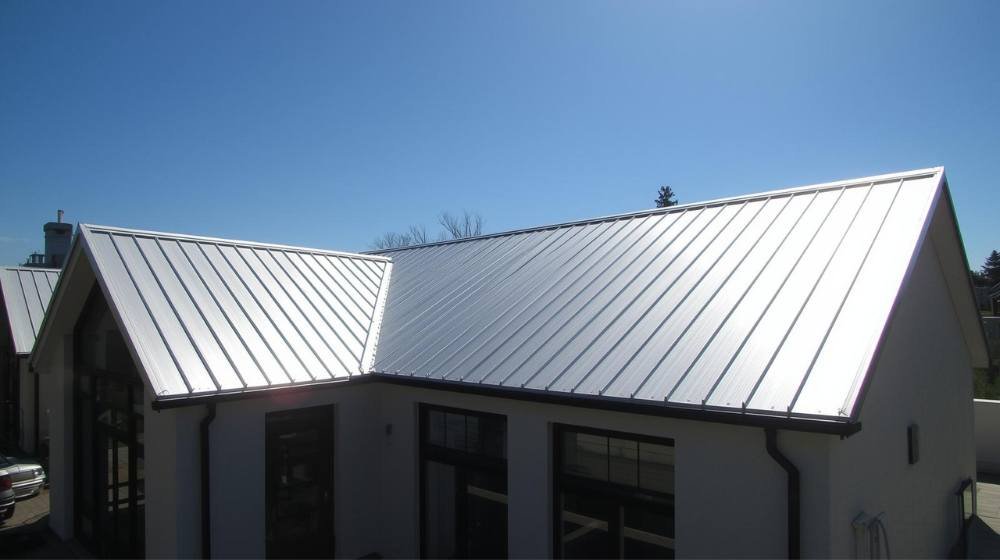
Additional Popular Roof Styles in Brooklyn
Brooklyn’s homes come in many styles, and the roof you choose can play a big part in the overall look and function of your home. Along with the more common roof types, here are three other popular roof styles seen in Brooklyn:
1. Butterfly Roof
- Info: The butterfly roof has two slopes that meet in the middle, forming a “V” shape. This unique design adds a modern touch to any home.
- Advantages:
- Adds a unique, striking look to your home.
- Perfect for bringing in natural light with large windows.
- Great for rainwater collection systems.
- Encourages airflow, keeping your home cool and comfortable.
- Eco-friendly with space for solar panels.
- Disadvantages:
- Complex to build and costly.
- It can leak if not built correctly.
- Needs regular maintenance to avoid water buildup.
- It may not blend well with traditional homes.
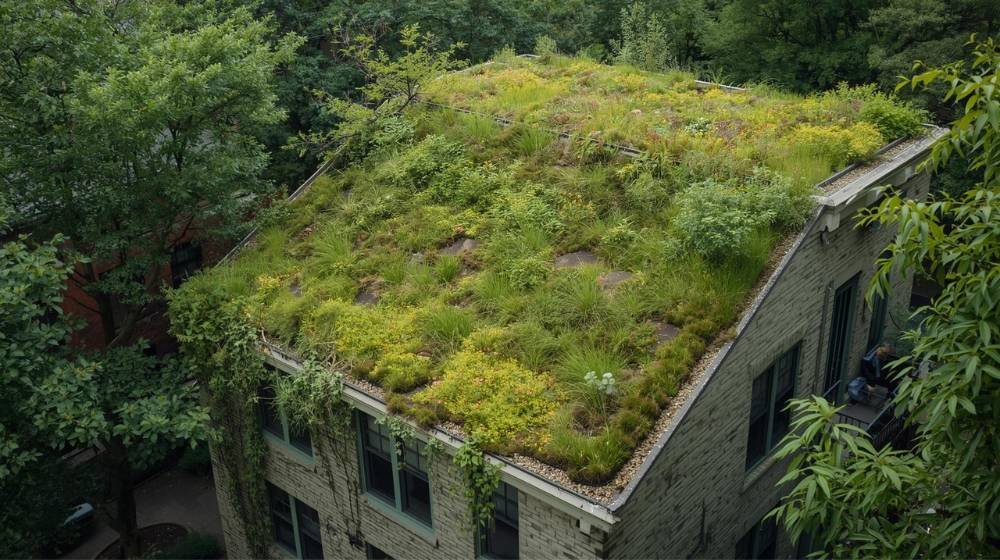
2. Green Roof
- Info: A green roof is covered with vegetation and soil. It provides an eco-friendly option for homes. It helps reduce heating and cooling costs while managing rainwater.
- Advantages:
- Reduces your carbon footprint and energy usage.
- Provides natural insulation for your home.
- Helps with stormwater management by absorbing rain.
- Adds extra green space in an urban setting.
- Enhances property value with an eco-friendly feature.
- Disadvantages:
- High installation and maintenance costs.
- Requires proper structural support to hold the weight.
- Requires ongoing care to ensure plants thrive.
- Not suitable for all neighbourhoods due to the style.
3. Shed Roof
- Info: A shed roof is a single-pitched design, often used in modern homes. It’s easy to build and offers a sleek, contemporary look.
- Advantages:
- Simple and cost-effective to build.
- The modern look fits well with minimalist homes.
- Allows for large windows and natural light.
- Ideal for small spaces or extensions.
- Provides easy access for installing solar panels.
- Disadvantages:
- Doesn’t offer much attic or upper-floor space.
- Limited in style options for traditional homes.
- It can look out of place in older neighbourhoods.
- Snow and rain can accumulate if not designed properly.
What Are the Costs of Different Types of Residential Roofs in Brooklyn, NYC?
The cost of installing a roof in Brooklyn can vary depending on the type of roof and the materials used. Below is a breakdown of the costs for different types of roofing:
| Roofing Type | Material Cost (per sq. ft.) | Labour Cost (per sq. ft.) | Total Cost (per sq. ft.) |
| Asphalt Shingles | $3 – $5 | $1 – $2 | $4 – $7 |
| Metal Roofing | $7 – $12 | $2 – $4 | $9 – $16 |
| Slate Roofing | $10 – $20 | $3 – $5 | $13 – $25 |
| Tile Roofing | $7 – $15 | $2 – $3 | $9 – $18 |
| Wood Shingles | $6 – $10 | $2 – $4 | $8 – $14 |
| Flat Roofing | $4 – $8 | $1 – $2 | $5 – $10 |
| Hip Roof | $6 – $12 | $2 – $5 | $8 – $17 |

What Are the Factors to Consider When Choosing a Roof Type: Expert’s Guide 💡
When choosing a roof for your home, it’s important to consider several key factors. Here’s an expert guide to help you make the right choice:
- Climate: Brooklyn experiences both cold winters and humid summers. The roof needs to be able to handle snow, rain, and heat. Make sure the material you choose is suitable for extreme weather conditions.
- Durability: Choose a roof that will last for many years. It should resist damage from rain, snow, and wind. A durable roof saves you money on repairs and replacements over time.
- Budget: Consider both installation and maintenance costs. Some roofs are cheaper to install but may cost more to repair. Ensure you understand the total cost of owning the roof over its lifetime.
- Aesthetic: Pick a roof that matches your home’s style. The roof should complement the architecture of your house. A roof that looks good will improve your home’s overall appearance.
- Energy Efficiency: Roofs can help keep your home cooler in summer and warmer in winter. Look for materials that provide good insulation. An energy-efficient roof can lower your energy bills.
- Maintenance: Some roofs require more care than others. A roof that needs less maintenance will save you time and money. Think about how much maintenance you’re willing to handle.
- Longevity: Choose a roof that will last long-term. Brooklyn’s weather can be harsh, so select a roof that won’t wear out quickly. A long-lasting roof is a better investment for your home.
What Are the Best Roofing Materials for Brooklyn’s Weather?
Brooklyn’s weather can be challenging, so it’s important to choose the right materials for your roof. Here are the best roofing materials for the area:
- Metal Roofing: Metal is durable and resistant to both wind and snow. It’s also energy-efficient, reflecting heat in the summer and insulating in the winter.
- Asphalt Shingles: Affordable and widely used, asphalt shingles are effective in both cold and humid climates. They are easy to repair and maintain.
- Slate Roofing: Slate is a high-end, durable material that can handle Brooklyn’s extreme weather. It lasts for decades with little maintenance.
- Wood Shingles: Wood is a natural insulator. This feature makes it a good option for homes that need temperature control. However, it requires more maintenance than other materials.
- Tile Roofing: Tile is excellent for shedding water and snow. It’s also durable and fire-resistant, making it ideal for areas with varied weather conditions.
Where to Find a Professional Roofing Contractor in Brooklyn, NYC?
Are you looking for an expert roofing contractor in Brooklyn, NYC? SR General Construction has you covered! Our business is located at 8807 Avenue B, Brooklyn, NY 11236, United States, in the Canarsie area.
We proudly serve all areas of Brooklyn with high-quality, durable roofing solutions. From new installations to repairs and maintenance, we provide the best service at affordable prices. Contact us and experience why we’re Brooklyn’s roofing experts!
FAQ
1. What is the best roof type for Brooklyn homes?
The best roof type for Brooklyn homes depends on your needs. For most homes, a hip roof is the ideal choice. It provides excellent protection against Brooklyn’s storms and snow, with its four sloping sides that ensure water and snow runoff. It’s also durable and energy-efficient.
2. How do I choose the right roof type for my house?
Consider factors like climate, budget, and aesthetic. In Brooklyn, choose a roof that can handle both the snow in winter and the heat in summer. A hip roof is an excellent option for durability and stability during storms.
3. How long does a hip roof last?
A hip roof can last anywhere between 20 and 50 years, or even longer with proper maintenance. Its durability makes it a good long-term investment for homes in places like Brooklyn.
4. What is the best roofing material for Brooklyn’s weather?
Metal roofing is ideal for Brooklyn’s unpredictable weather. It’s durable, weather-resistant, and energy-efficient. It offers protection against snow, rain, and high winds.
5. Are green roofs worth it in Brooklyn?
Yes, green roofs are eco-friendly and provide excellent insulation. They help with stormwater management, reduce energy bills, and offer a unique outdoor space. However, they come with higher installation and maintenance costs.
6. Can I install solar panels on a shed roof?
Yes, shed roofs are ideal for installing solar panels. The slanted design allows for easier installation of panels, and the roof’s modern design is energy-efficient. It helps to save on electricity bills.
7. What is a butterfly roof, and is it suitable for Brooklyn?
A butterfly roof features two slopes that meet in the middle, forming a “V” shape. It’s a striking and modern design that works well in Brooklyn’s urban areas. However, it requires complex installation and may not be suitable for traditional homes.
8. What is the cost of installing a hip roof in Brooklyn?
The cost of a hip roof can range from $8 to $17 per square foot, including both materials and labour. The price depends on factors like material choice, roof size, and the complexity of the installation.
